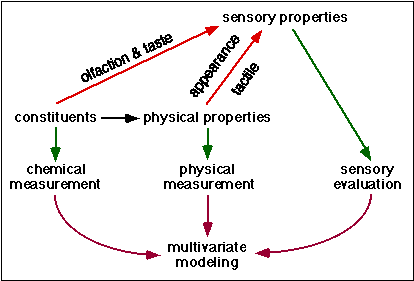Composition / Property Relationships

Modeling the relationships between product composition and properties
Among the most important food product properties defining quality are those the consumer perceives directly with his or her own senses. These include appearance (color, haze, foam), tactile sensations (rheology and texture) and flavor (olfaction, taste and chemesthesis). In all cases, the perceived properties are derived from product constituents that exert an influence on physical or sensory properties; these can be assessed by people and often by instruments. In most cases the relationships between product composition and properties are multivariate, involving interactions such as additivity (joint perception of compounds with similar properties) or masking. The physical ‘functional’ properties typically are derived from the chemical structure and interactions of the constituents. Instrumental measurements may or may not relate well to human perceptions due to the generally poorer reproducibility of sensory assessments and to differences between the perceptions of people and instruments. Humans are often more sensitive for olfaction and less sensitive for appearance factors. Multivariate modeling procedures can help to identify the constituents of a food product that contribute to its functional properties (quantitative structure activity relationships) and their perceptions by people and instruments. They can also discern relationships between instrumental and sensory measurements.
Program Activities and Outputs
T.L. Peppard, S.A. Ramus, C.A. Witt, and K.J. Siebert. 1989. Correlation of sensory and instrumental data in elucidating the effect of varietal differences on hop flavor in beer. J. Amer. Soc. Brew. Chem. 47: 18-26. abstract
K.J. Siebert and T.E. Acree. 1993. The sensory and chemical basis of beer flavor. Cerevisia and Biotechnology 18(2):29-39. abstract
K.J. Siebert. 1994. Sensory analysis of hop oil-derived compounds in beer; Flavor effects of individual compounds. Quality Control. In Monograph XXII E.B.C. Symposium on Hops, European Brewery Convention, Zoeterwoude, The Netherlands. pp. 198-215. abstract
A. Carrasco & K.J. Siebert. 1999. Human visual perception of haze and relationships with instrumental measurements of turbidity. Thresholds, magnitude estimation and sensory descriptive analysis of haze in model systems. Food Qual. & Pref. 10 (6): 421-436. abstract
K.J. Siebert. 1999. Modeling the flavor thresholds of organic acids in beer as a function of their molecular properties. Food Qual. & Pref. 10 (2): 129-137. abstract
K.J. Siebert. 2000. Relationship of particle size to light scattering. J. Amer. Soc. Brew. Chem. 58 (3): 97-100. abstract
K.J. Siebert. 2001. Quantitative structure-activity relationship modeling of peptide and protein behavior as a function of amino acid composition. J. Agric. Food Chem. 49 (2): 851-858. abstract
S. Carpino, T.E. Acree, D.M. Barbano, G. Licitra, and K.J. Siebert. 2002. Chemometric analysis of Ragusano cheese flavor. J. Agric. Food Chem. 50 (5): 1143-1149. abstract
K.J. Siebert and P.Y. Lynn. 2003. The effects of alcohol and pH on protein-polyphenol haze intensity and particle size. J. Amer. Soc. Brew. Chem. 61 (2): 88-98. abstract
K.J. Siebert and A.W. Chassy. 2003. An alternate mechanism for the astringent sensation of acids. Food Qual. & Pref. 15 (1): 13-18. abstract
Siebert, K.J. 2003. Modeling protein functional properties from amino acid composition. J. Agric. Food Chem. 51(26): 7792-7797. abstract
Tan, Y. and Siebert, K.J. 2004. Quantitative Structure-Activity Relationship modeling of alcohol, ester, aldehyde and ketone flavor thresholds in beer from molecular features. J. Agric. Food Chem. 52 (10): 3057-3064. abstract
Fleet, C.F. and Siebert, K.J. Effect of illumination intensity on visual perception of turbidity. Food Qual. & Pref. 16 (6): 536-544, 2005. abstract
Fleet, C.F. and Siebert, K.J. Effect of viewing background on visual perception of turbidity. J. Sens. Stud. 21 (1): 34-53, 2006. abstract
Tan, Y. and Siebert, K.J. Modeling bovine serum albumin binding of flavor compounds (alcohols, aldehydes. esters and ketones) as a function of molecular properties. J. Food Sci. 73 (1): S56-S63, 2008. abstract
Siebert, K.J. and Euzen, C. The relationship between expectorant pH and astringency perception. J. Sens. Stud. 23 (2): 222-233, 2008. abstract
Siebert K.J. Visual versus instrumental perception of haze – A review. Tech. Q. Master Brew. Assoc. Am. 45 (2): 90-98, 2008. abstract
Siebert K.J., Maekawa, A.A. and Lynn, P.Y. The effects of green tea drinking on salivary polyphenol concentration and perception of acid astringency. Food Qual. & Pref. 22: 157-164. 2011. abstract
